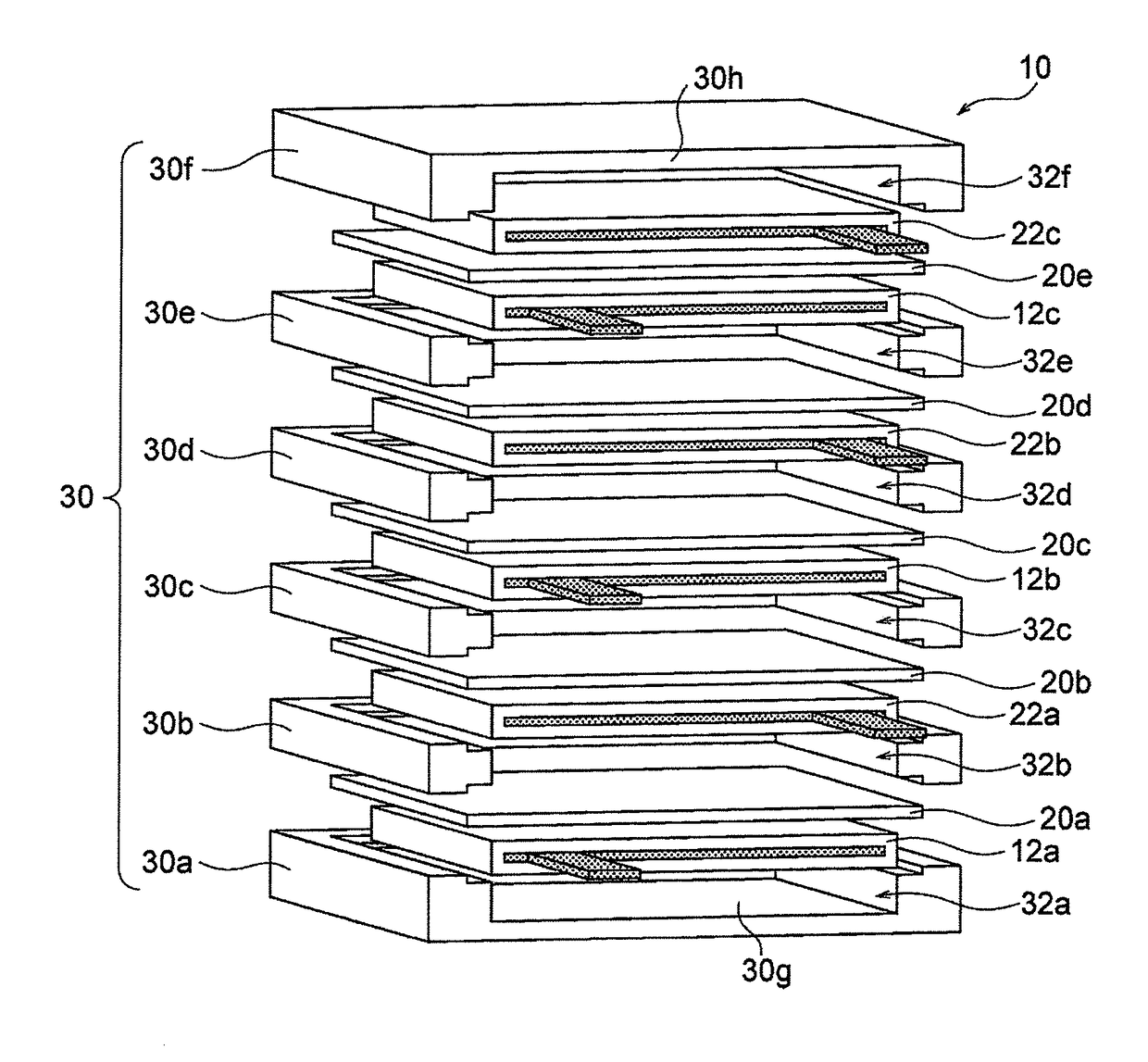Battery and assembly method therefor
- Summary
- Abstract
- Description
- Claims
- Application Information
AI Technical Summary
Benefits of technology
Problems solved by technology
Method used
Image
Examples
example 1
Preparation and Evaluation of LDH Separator with Porous Substrate
[0121](1) Preparation of Porous Substrate
[0122]Boehmite (DISPAL 18N4-80, manufactured by Sasol Limited), methyl cellulose, and ion-exchange water were weighed in proportions by mass of 10:1:5, and were then kneaded together. The kneaded product was subjected to extrusion molding with a hand press into a plate having a size sufficiently exceeding 5 cm×8 cm and a thickness of 0.5 cm. The resultant green body was dried at 80° C. for 12 hours and then fired at 1,150° C. for three hours, to prepare an alumina porous substrate. The porous substrate was cut into a piece of 5 cm×8 cm.
[0123]The porosity at the surface of the resultant porous substrate was determined by a method involving image processing. The porosity was 24.6%. The porosity was determined as follows: 1) a scanning electron microscopic (SEM) image of the surface microstructure of the porous substrate was taken with a scanning electron microscope (SEM; JSM-6610L...
example 2 (
REFERENCE)
Production and Evaluation of Nickel-Zinc Battery
[0144]Example 2 is a reference example based on a unit cell including a single set of a positive electrode plate, a separator, and a negative electrode plate.
[0145](1) Preparation of Separator with Porous Substrate
[0146]A separator provided with a porous substrate (LDH membrane on alumina substrate) (size: 5 cm×8 cm) was prepared as in Example 1.
[0147](2) Preparation of Positive Electrode Plate
[0148]Particulate nickel hydroxide containing zinc and cobalt in the form of solid solution was prepared. The particulate nickel hydroxide was coated with cobalt hydroxide to yield a positive-electrode active material. The positive-electrode active material was mixed with a 2% aqueous carboxymethyl cellulose solution to prepare a paste. The paste was evenly applied to a current collector composed of a nickel porous substrate having a porosity of about 95% and dried so that the porosity of the positive-electrode active material was 50% t...
example 3
Solvent Bonding of ABS Resin
[0156]Five ABS resin plates with a thickness of 1 mm were joined by solvent bonding into a box container. More specifically, two resin plates 302 were fixed together with a zig 304 such that the edges of the resin plates 302 were in contact with each other at an angle of 90 degrees, methyl ethyl ketone (MEK) solvent was applied to the joint portion 306 between the resin plates 302 with a brush 308, and then a solvent was poured into the gap in the joint portion, as shown in FIG. 20. In the present Example, the two resin plates 302 were tightly fixed together so as to reduce the gap in the joint portion 306, and then the solvent was poured therein. As a result, the solvent spread in and around the gap due to capillary action. Such a procedure was repeated until the five resin plates 302 were mutually solvent-bonded. The box container 300 shown in FIG. 20 was thereby produced. Finally, it was confirmed whether a gap due to inadequate bonding was present at ...
PUM
 Login to View More
Login to View More Abstract
Description
Claims
Application Information
 Login to View More
Login to View More - R&D
- Intellectual Property
- Life Sciences
- Materials
- Tech Scout
- Unparalleled Data Quality
- Higher Quality Content
- 60% Fewer Hallucinations
Browse by: Latest US Patents, China's latest patents, Technical Efficacy Thesaurus, Application Domain, Technology Topic, Popular Technical Reports.
© 2025 PatSnap. All rights reserved.Legal|Privacy policy|Modern Slavery Act Transparency Statement|Sitemap|About US| Contact US: help@patsnap.com



